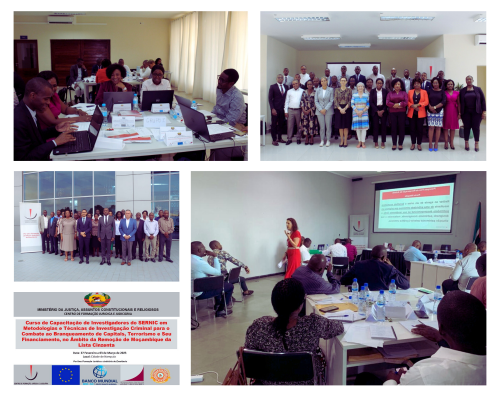Beneficial ownership transparency is a pillar of anti-money laundering systems – so it needs to stand up. Insights from the Basel AML Index 2021

Our recently released Basel AML Index 2021 highlights how slow and ineffective implementation of beneficial ownership registries continues to provide safe havens for dirty money.
We argue that this is damaging for individual jurisdictions, but more importantly undermines all global efforts to combat money laundering and terrorist financing (ML/TF). Excerpt from the full report:
Beneficial ownership and resilience to ML/TF threats
Beneficial ownership transparency is directly related to the effectiveness of a jurisdiction’s AML systems and the essential role of these systems in preventing, detecting, prosecuting and sanctioning financial crimes. It is therefore crucial to a jurisdiction’s resilience against ML/TF threats.
Both public authorities (law enforcement, Financial Intelligence Units) and private actors (financial institutions and Designated Non-Financial Businesses and Professions, or DNFBPs) are responsible for maintaining this resilience.
For public authorities, low transparency of beneficial ownership and anonymity of some legal arrangements hamper ML/TF investigations and attempts to trace and freeze illicit assets.
This is because of the very nature of money laundering, which is to disguise the criminal origins of money and take a number of actions to introduce it into the financial system and make it appear legal. Criminals often use complex “layers” of legal corporate structures spanning multiple jurisdictions to hide the illicit origin of their money.
If such layering activities remain undetected, the money is more easily integrated into the financial system. It then becomes much more difficult for law enforcement authorities to identify and prosecute the crimes and to recover whatever is left of the money.
This is especially the case where the trail of the money passes through multiple jurisdictions with very different methods for recording and sharing beneficial ownership information.
This problem of opaque beneficial ownership arrangements also applies to terrorist financing crimes, where criminals aim not only to stay undetected but to circumvent sanctions lists.
For the private sector, the information contained in beneficial ownership registers is also essential to effective AML / CFT compliance processes.
Financial institutions and DNFBPs effectively play a gate-keeping role to prevent illicit money from entering the financial system. Without proper access to reliable information on beneficial ownership, private actors have a limited ability to understand who is behind the legal entities and legal arrangements – i.e. a limited ability to fulfil their customer due diligence requirements.
They are therefore not able to perform their role of preventing financial crimes and of protecting their own businesses to their full capacity.
The financial institutions and DNFBPs themselves also suffer as a result of a jurisdiction’s dysfunctional or nonexistent beneficial ownership transparency: poor AML compliance increases their exposure to legal, reputational and financial (fines) risks.
Beneficial ownership transparency has risen up the global agenda
The Financial Action Task Force (FATF) published the first international standards on beneficial ownership transparency in 2003. 190 jurisdictions committed to implementing legal requirements for:
- financial institutions and other gatekeepers to collect and verify information on the ownership of legal persons and arrangements;
- measures to ensure that this information is available competent authorities.
The standards were revised in 2014 to provide more clarity, close loopholes and better distinguish between basic ownership information (about the immediate legal owners of a company or trust) and beneficial ownership information (about the persons who ultimately own or control it). In 2019, FATF published best practices on beneficial ownership for legal persons.
There is now widespread consensus that beneficial ownership registers are needed not only to combat ML/TF but also tax evasion and other forms of financial crime, to assist in tracing and recovering stolen assets, and – especially for publicly available registers – for their deterrent effect.
This concern has been picked up by a multitude of policy and advocacy bodies from all sectors. The G20, B20 and C20, the OECD and its Global Forum on Transparency and Exchange of Information for Tax Purposes, the Extractive Industries Transparency Initiative (EITI), the Open Government Partnership through its Beneficial Ownership Leadership Group, and Transparency International are just a few of those calling actively for the establishment of effective beneficial ownership registers globally.
Open Ownership, an NGO, has developed Principles for Effective Beneficial Ownership Disclosure, which provide a framework for implementing beneficial ownership reforms and assessing the adequacy of existing measures.
Far from being a purely technical issue, beneficial ownership is also increasingly a public demand following scandals such as the Panama and Paradise Papers. These have revealed how anonymous shell companies have been misused (and in many cases intentionally set up for that purpose) to assist criminals and professional money launderers in hiding the proceeds of corruption and other crimes.
Implementation and effectiveness of beneficial ownership registers
Despite the fact that the importance of beneficial ownership transparency is increasingly recognised, implementation remains uneven and more clarity and granularity are necessary. To gain a greater understanding of the main weaknesses, and perhaps draw first conclusions of the underlying reasons, we examined what the FATF data reveals on this question.
For this, we looked at the following FATF Recommendations and effectiveness indicators (IO5) for beneficial ownership:
| Technical compliance | Effectiveness |
|---|---|
| R.24: Transparency and beneficial ownership of legal persons. Jurisdictions should take measures to prevent the misuse of legal persons for money laundering or terrorist financing. | IO5: Legal persons and arrangements are prevented from misuse for money laundering or terrorist financing, and information on their beneficial ownership is available to competent authorities without impediments. |
| R.25: Transparency and beneficial ownership of legal arrangements. Jurisdictions should take measures to prevent the misuse of legal arrangements for money laundering or terrorist financing. |
The data covers 112 jurisdictions assessed under the FATF’s fourth-round methodology. Note that data collection ended in July 2021. The data do not reflect the recent changes with regard to beneficial ownership in the US and Canada, as these jurisdictions have not undergone an FATF evaluation since the changes came into effect.
The analysis reveals poor performance across the board.
- Technical compliance with R.24 and R.25 across all 112 assessed jurisdictions lies at only 47% on average.
- Almost half of the jurisdictions (44%) score zero for the effectiveness of their beneficial ownership transparency measures under IO5 – 49 jurisdictions out of the 112 assessed.
- No jurisdiction has an effective system, where IO5 is achieved to a very large extent.
- Only 11 jurisdictions out of the 112 score 66% for effectiveness. A further 52 jurisdictions demonstrate just 33% effectiveness.
- The average effectiveness score across all assessed jurisdictions is only 22%.
As explained above and emphasised repeatedly by the FATF, this lack of effective collection and verification of information on the beneficial owner of a corporate vehicle hinders the efforts of law enforcement and financial institutions to prevent or investigate abuse of the financial system.
What will happen if the FATF strengthens requirements on beneficial ownership transparency?
The data also seem to indicate that the non-binding nature of the FATF Recommendations on beneficial ownership leaves a great deal of flexibility in the way that jurisdictions implement them in their national legislation. Is this the reason for the uneven and tardy implementation?
The FATF has conducted a public consultation this year on possible amendments to R.24 on the transparency and beneficial ownership of legal persons, the outcomes of which are pending at the time of writing this report. It is hoped that this process will shed more light on the causes of the current weakness of existing beneficial ownership frameworks and the lack of such frameworks in far too many jurisdictions still.
Based on our analysis of jurisdictions in the Basel AML Index, we predict that average performance will decrease if the FATF strengthens its requirements under R.24.
Beneficial ownership transparency in the EU
The case of the European Union illustrates that implementing effective beneficial ownership registers remains challenging even in a region with substantial resources at its disposal, a relatively low risk of ML/TF (see regional profile, page 27) and, importantly when comparing to the global standard, very clearly defined mandatory rules.
These rules for EU Member States are set out in the so-called EU AML Directives (AMLD).
- The 4th AMLD signed in 2015 required Member States to ensure that the beneficial owners of legal persons and some trusts should be known and registered with an authority.
- The 5th AMLD required that beneficial ownership registers for companies and legal persons should be publicly accessible, and that beneficial ownership information on trusts should be accessible to competent authorities, financial institutions and designated non-financial business and professions (DNFBPs), as well as anyone who can demonstrate a legitimate interest. By January 2020, Member States were supposed to have transposed the 5th AMLD into domestic law.
Although the 5AMLD set out the necessary framework for establishing transparent beneficial ownership across EU jurisdictions, there remain gaps in implementation of these standards in national legislation as well as weaknesses in supervision at the EU level.
As pointed out by Transparency International, three jurisdictions (Italy, Hungary, Lithuania) still have not established any form of beneficial ownership register. A further six (Cyprus, Czech Republic, Finland, Greece, Romania and Spain) have failed to make their registers public, as required in the 5AMLD. Others restrict access in different ways.
So the problem seems to be going further than “just” the question of how specific the rules are. In July 2021 the EU presented what it calls an “ambitious package of legislative proposals” to strengthen and harmonise AML / CFT rules across Member States, including beneficial ownership transparency requirements. It can be hoped that with this, combined with the ongoing revisions of relevant FATF standards, at least the high-risk countries will start understanding the critical role of beneficial ownership registers in both ML/TF prevention and enforcement, and act on it.
Are compliant systems more effective?
Actually, no. Interestingly, the data reveals no strong correlation between technical compliance and effectiveness.
- Only nine jurisdictions demonstrate a high performance (above 50%) in both technical compliance and effectiveness ratings: Armenia, Bermuda, Cuba, Cook Islands, Italy, Israel, Macao, Spain and the UK.
- Some jurisdictions, such as Latvia and Iceland, score highly on technical compliance criteria (67% and 83% respectively) but zero in terms of effectiveness.
The US and Canada are among those jurisdictions that have been – at least until now – let down by their ineffective beneficial ownership transparency measures. Both fall into the medium-risk category in the Basel AML Index: Canada is rated at 4.67 and the US at 4.60 out of a maximum ML/TF risk score of 10.
However, both jurisdictions suffer from beneficial ownership transparency systems rated by the most recent FATF evaluation as 0% effective.
What can we learn from analysing FATF data on beneficial ownership?
The analysis shows, among other things, that:
- There is still an unacceptably poor level of compliance in establishing beneficial ownership registers (or other mechanisms), even when this is required not only by FATF standards but by law. In some jurisdictions, this is a major aspect letting down their otherwise acceptable performance in AML/CFT.
- The majority of beneficial ownership registers that do exist are either mostly or completely ineffective at doing even the minimum that they are supposed to do – provide reliable information to the competent authorities on the ultimate beneficial owners of companies or trusts incorporated in the jurisdiction.
Increasing the transparency of information on beneficial ownership is both an obvious and an essential measure to improve the general level of AML/CFT compliance and to help prevent or investigate ML/TF offences.
This applies both domestically (since no jurisdiction has a fully functioning beneficial ownership system) and internationally (due to the cross-border nature of financial crimes).
Strong government action to improve beneficial ownership transparency will support not only the competent authorities responsible for investigating and prosecuting financial crimes, but also financial institutions and other reporting entities with their customer due diligence obligations.
Further reading on beneficial ownership and money laundering
- Position Paper on Beneficial Ownership Transparency (2021) by the Global Coalition to Fight Financial Crime
- Quick Guide to Offshore Structures and Beneficial Ownership (2020) by Phyllis Atkinson, Head of Training ICAR at the Basel Institute on Governance
- Principles for Effective Beneficial Ownership Disclosure (2021) by Open Ownership
- Beneficial Ownership Registers: Progress to Date (2020) by the U4 Anti-Corruption Helpdesk
- Best Practices on Beneficial Ownership for Legal Persons (2019) by the FATF
More from the Basel AML Index
- Find out about the Basel AML Index, view the latest Public ranking and find out whether your organisation is eligible for a free Expert Edition account at our brand new website: index.baselgovernance.org.
- See the Basel AML Index 2021 press release.



